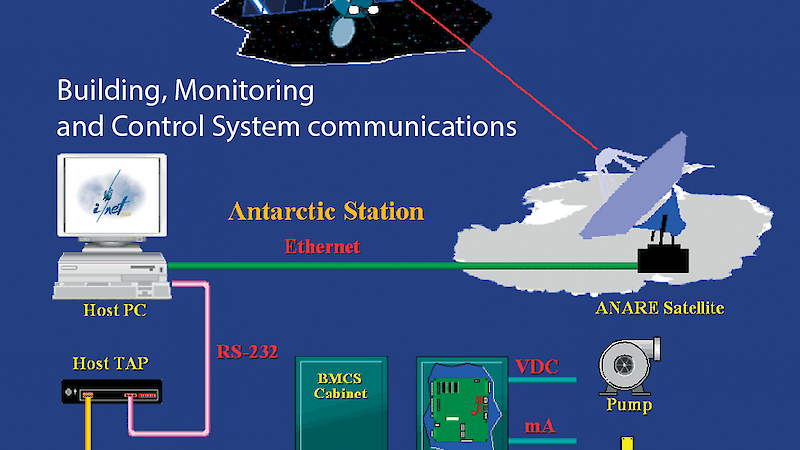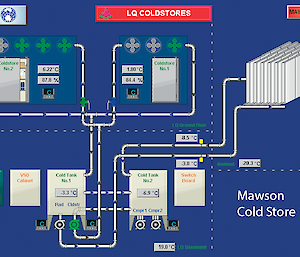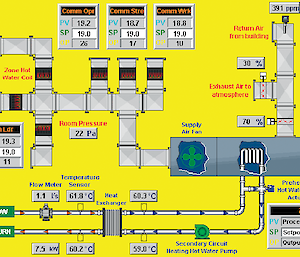Australia’s four permanent stations — Casey, Davis, Mawson and Macquarie Island — have a primary role as a base for the support of science. In 1997, the Antarctic Science Advisory Committee (ASAC) questioned the ongoing need for four permanent stations and suggested that a more flexible approach to supporting science may be more appropriate. The option of closing or mothballing one or more stations was suggested as one means of funding this flexibility.
Unfortunately, the integrated nature of the stations, primarily due to the use of heating water as the main means of heating the station buildings, makes the concept of mothballing, even for a single winter, a difficult and costly exercise. As a result, opportunities to reduce the operating costs of the stations through efficiencies in their operation are actively being sought. The aim is to provide the required flexibility with stations that are available throughout the year, but that require minimal costs to operate during the times of reduced station population.
This article discusses the use of a Building Monitoring and Control System (BMCS) as a tool to better understand the various engineering systems in place at Australia’s continental stations so that their operation may be monitored and optimised.
Station description
In the early 1980s Australia commenced a program of replacing the old timber station buildings with modern, steel-framed, energy-efficient buildings. This rebuilding program was completed in the mid-1990s, leaving Australia with large, modern and comfortable stations.
The stations consist of a number of discrete buildings to reduce the impact of any fire. The buildings are thermally efficient and have sophisticated heating and ventilation systems.
Power at the stations is produced using diesel generator sets. Each station has two powerhouses and the main powerhouse at each is fitted with four generator sets of 110kW rated capacity. As station electrical load varies, either two or three of these engines is required to meet the electrical needs of the station.
Maximum use is made of the waste heat that is generated in the powerhouses by using it to heat water. This hot water is pumped around the stations and provides the primary means of heating the buildings. Fuel-fired boilers supplement this system when required. As a result of the integrated nature of the engineering systems on the stations, the systems need to be managed as a whole to allow the station energy usage, and hence operating costs, to be minimised.
The first step in managing any system is to understand it. A BMCS has been installed at Casey, Davis and Mawson stations, initially to monitor systems and provide data, and then to allow systems to be centrally controlled to optimise their use.
The Building Monitoring and Control System basics
A control system is not unlike a standard computer system in that it consists of inputs, outputs, hardware and software:
- The inputs to a control system are in the form of sensors and switches such as temperature sensors or push button switches.
- The hardware in the Australian Antarctic Division’s case is a Single Board Computer (SBC). Other sorts of control system hardware include Distribution Control Systems (DCS), Programmable Logic Controllers (PLC) or Micro Controllers.
- The outputs for a control system can be either hardware-based such as starting a pump, opening a valve or turning on a light, or software-based such as raising an alarm, collecting field data or undertaking calculations.
- Software in a control system is usually programmable by the end user. Its main purpose is to let the hardware know how to monitor the inputs and control the outputs. Our system software is ‘inet 2000'.
The BMCS project
The BMCS project commenced in late 1997. The initial step was to commission an audit of the existing local monitoring and control system (LMCS) and of the engineering systems at the stations in an attempt to quantify the value of any savings that may result from an upgrade to the LMCS. However, the impetus for the project came when the audit revealed that the existing data loggers used by the LMCS were not Y2K compliant. Additional funding became available in mid-1998. A specification was developed and tenders called in late 1998. A preferred tenderer was selected, and work commenced with a view to delivering equipment to the stations on the last voyage of the 1998–99 season.
This deadline was met, and in February 1999 the system was despatched with recently recruited and trained electricians to Mawson, Davis and Casey.
Across the three stations a total of 63 cabinets containing 115 Process Control Units were installed. Over the next five months, the Project Electricians between them connected up approximately 2800 of the existing sensors and switches. Programing was carried out concurrently with the installation of the sensors and switches and was completed in October 1999. Thus, the initial system was up and running within eight months of the arrival of the equipment.
The present system can be monitored, programed and configured from the AAD’s head office at Kingston. This is achieved through the AAD’s satellite-based Wide Area Network. This is particularly useful feature of the system in that it provides a way in which Head Office engineers can assist the on-site trades people in the maintenance and operation of the stations.
Monitoring to date
It was mentioned earlier that hot water is pumped around the stations and provides the primary means of heating the buildings. The system of pipes, locally referred to as ‘Site Services', that carry the heating hot water also carry potable and fire sprinkler water as well as the sewage (though not all in the same pipe!). These pipes are heat traced, which is perhaps best described as ‘electric blankets’ on the pipes. Designed to turn on when the pipe gets too cold, they prevent the pipe from freezing. The BMCS monitors the temperatures within these pipes and the status of the heat trace, and has been used to safely reduce the time that the heat trace is on, thus reducing the energy used by the system.
Water production at Mawson and Casey consists of a melt bell that utilises heat from the site services, supplemented by a diesel-fired boiler, to melt fresh water in melt lakes adjacent to the stations. At Davis, a reverse osmosis plant produces water over the summer months from a saline tarn. This water is stored in two 600 kl tanks for use over winter. The BMCS monitors the flow and pressure of the potable water system, and has been connected to storage tanks to give an indication of water levels and water production rates.
Within the main buildings, the BMCS is monitoring the temperature in a range of building spaces and controlling primary and zone specific air heating coils. More recent modifications have allowed the BMCS to control the whole heating, ventilation and air handling systems of some buildings to reduce the energy consumed while maintaining the building amenity. The system also monitors the status of electrical switchboards, fire panels and powerhouse engines.
Other uses to date include using the BMCS to monitor air quality (CO2, CO, Methane and Hydrogen Sulphide), and to monitor wind speed, wind direction and relative humidity through an interface with the meteorological automatic weather stations. A recent innovation uses the text alarms generated by the system to send alarms to pagers that are capable of receiving text messages. This system allows a duty trades person to be in 24-hour contact with the equipment for which they are responsible. Some quantified case studies are provided to illustrate the typical savings and efficiencies that have been achieved to date.
Mawson cold store project case study
At Mawson station, a new cold store was constructed over the winter of 1999. The cold store uses outside radiators as heat rejection units and has conventional refrigeration compressors as a backup. The final result is two energy-efficient cold stores used for the long-term storage of fresh food, one at 6°C and one at 2°C.
When completed, the cold stores used on average 20 kWh per day compared to the original refrigerated containers that had an estimated usage of over 100kW per day. The BMCS was connected to the system over the 1999–2000 summer to control the number of fans and pumps in use, and the total energy usage of the cold stores dropped to 16kW — a saving over the ‘uncontrolled’ system of 20%. Over the 2000 winter, the colder outside temperatures allowed usage to drop to approximately 7kW per day.
Davis workshop lighting project case study
An energy audit was undertaken at Davis Station in 1998. An analysis of the results revealed that the Davis workshop seemed to have an inexplicably high energy usage, especially when compared to other similar sized buildings. Investigations revealed that the lighting was a major consumer of electrical power. The latest lighting systems were researched and it was decided to replace the existing system.
A total of 327 old fluorescent tubes were replaced with 172 triphosphur tubes mounted in new mirror-like reflectors. The new lights were rotated to maximise use of reflection from walls, and lowered. They were also powered through a proprietary ‘Eco-Box’ light voltage control system. The light switching system was also replaced using Clipsal’s C-BUS technology. This allowed the automatic switching on of lights to provide a pathway, it allowed people to choose the amount of light they required, and it provided a means for people to switch off all the lights in the workshop with a single switch located at each exit. The C-BUS system included 15 PIRs, a total of 50 new switches, and the grouping of lights into 44 groups. The whole building was then connected to the BMCS for duplicate control. The end result was a 40% increase in the light levels available.
Other changes in the building included BMCS control of the air handling system, the workshop air compressor, and the floor heating coils. The total reduction in energy usage as a result has been estimated to be 56%. Based on the then pump price for diesel, this represents a pay-back of less than two years.
Mawson heating hot water pump project case study
The design of the heating hot water pipe network includes a ‘primary circuit’ which travels around the station through each of the buildings. A ‘secondary circuit’ within each building uses a heat exchanger to remove the amount of heat required for the building from this primary circuit. The original design of the system has the main circulating pump running at constant speed.
A Variable Speed Drive (VSD) controlled by the BMCS has been installed on the main site services heating hot water circulating pump over the 2000–01 summer. Initial results indicate that this may be our best ever return on investment! The variable speed drive slows down the rate at which the heating hot water is pumped around the station thus saving energy. It has no effect on the heating of the buildings as, during summer, they require very little heating.
When the pump operates in its normal mode, it consumes around 22kW of power and pumps water around the station at a rate of 17 litres/second. Slowing the pump down to 70% (to 12 litres/second) the pump consumes 9kW of power. Therefore, a 30% reduction in speed results in a 60% reduction in energy consumption. The VSD was initially run for almost three weeks from late December to mid-January and consumed 6.4 MWh of energy, compared with just over 10 MWh if the pump had run normally. Results such as these mean that the pay-back period, for all the materials and labour, is around 42 days. It is envisaged that savings can continue to be achieved up until the end of March and after that time, there will probably be no benefit as the pump will have to run at 100% of the time in order to keep up with the station heating load.
Conclusions
The BMCS project has allowed the Australian Antarctic Division to gain a better understanding of energy usage at the three Antarctic Stations of Davis, Casey and Mawson. It has also allowed the automation of some of the station engineering systems, which have allowed them to be optimised resulting in a reduction in operating costs of the stations. It is expected that a number of other projects will be able to be completed over the coming years that will allow the operating costs to be reduced even further.
Chris Paterson1 and Jeremy Bonnice2
1. Chief Engineer, Australian Antarctic Division
2. Instrument and Control Engineer, Australian Antarctic Division



